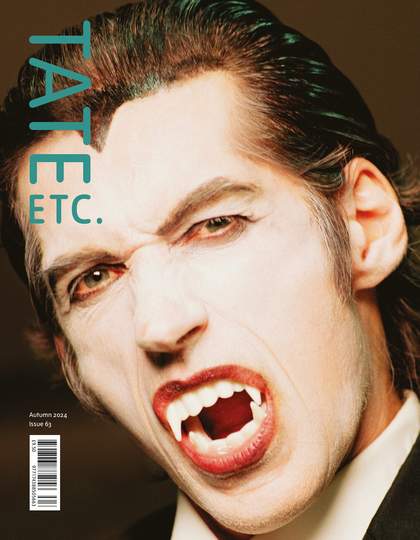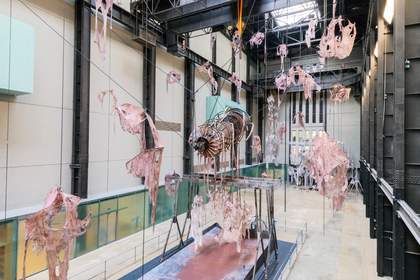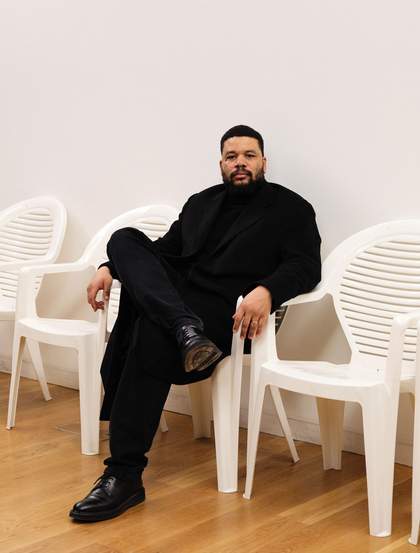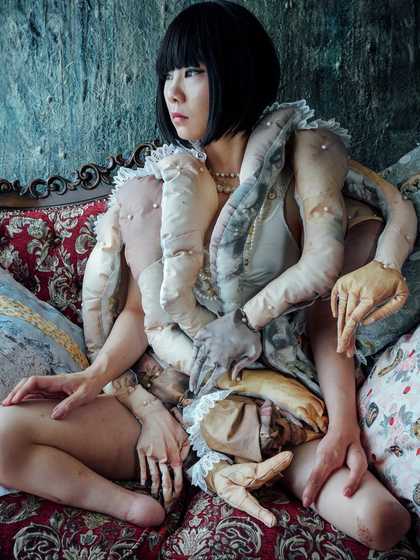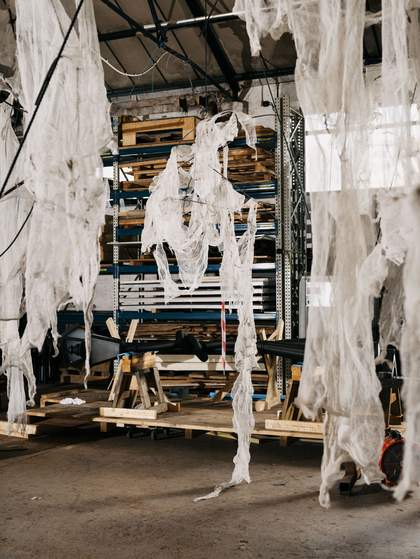
AMI LIEN The Turbine Hall is a massive and, to me, very confusing space. Visitors enter from different points and move towards different goals, but it’s not necessarily so obvious how to move through it. It’s like a confusing traffic intersection. I’m interested to hear how your commission will carve out a different path through the space.
MIRE LEE The Turbine Hall is very high and feels like a vertical space, but, taken as a whole, it’s actually horizontal, longer than it is tall. Ever since I was in art school, I’ve had a desire to make things as big as possible and, as soon as the commission was confirmed, I knew I wanted to fill this space as much as possible. I’ve also always wanted to make something that looked, or felt like, the inside of an animal – like a typical vore1 fetish image of being inside a whale or another huge animal. So, my very first idea, which I had to drop because it would have been very expensive, was to lay out construction scaffolding inside the Turbine Hall, so it would become a bit like the skeleton inside an animal’s body.
AL You’re engaging with a very monumental scale here, which is something that artists don’t often have an opportunity to play with. There is a compelling tension in your work, I think, between monumentality and melancholia.
ML I’m interested in accentuating the sadness of monumentality, or how monumentality is essentially connected to stupidity or tragedy, because when you see something human-built and monumental, there’s an underlying understanding of how much labour has gone into it, which is surely based on inequality – between the builders and the people who have hired them, and between the perceived higher capacity of the artist or architect and the workers who actually execute the project. The aesthetic experience of monumentality is, I think, an experience of violence, even if we don’t notice it right away.
AL You’re describing a hierarchy, and I wonder if, by focusing on the horizontality of the space, you’re consciously toppling the vertical in your approach?
ML It’s not that logical. But for sure, when making a sculpture, I want to see it on the ground sometimes. As soon as it’s on the ground, it looks funny and sad and stupid. You can create affect very easily with sculptures or materials by just putting them on the ground or destroying them a little bit.
AL That’s a nice lesson in affect production – I’ll try it some time. So, how did you keep moving forward with crafting a work for this space?
ML I was inspired by a picture of the original turbines sitting in Bankside Power Station, before they were decommissioned, and a crane that was used to move things around the hall. It was gigantic – I wanted to steal the charisma of that crane! In my first proposal, I wrote that I wanted to create an ‘industrial womb’, a sort of machine that produces continuously over time.
I like to choose a starting point that’s quite blunt, and then bring in other ideas as I go, to make it more elaborate. I also rely on the input of other people around me, and beginning with imagery that is quite simple allows room for them to bring their own interpretations and contributions. For example, when we had to drop the scaffolding idea, Stephan, my advisor, showed me a photograph of a miners’ changing room, which has become an important reference. Then Alvin, the curator of the project, wanted to bring a durational aspect to the work, something that changes or accumulates over the course of the five-month run of the show. And then there have been the texts you’ve written and sent to me, which have been amazing to read.
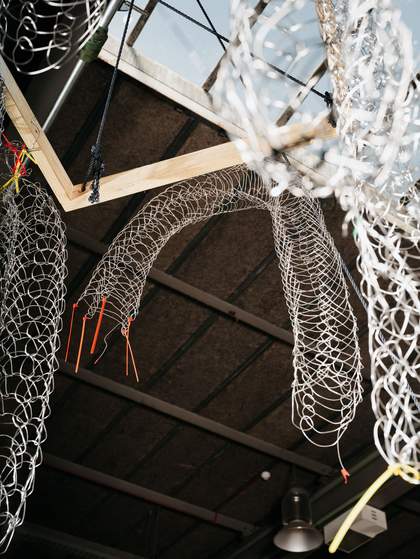

AL I’m glad to hear how integral collaboration has been to your process. I think some of the more hidden aspects of being artists are the opportunities we have to test and model collective work. I’m curious about the miners’ changing room reference. Could you share more about that?
ML It’s a changing room system that has been used in certain coal mines in Europe. Each miner has a basket of their own, where they put their dirty work clothes at the end of the day. The image of the room immediately attracted me because it looked amazing, and I loved the idea of the basket as an individual private space in this collective workspace. There is a kind of cruelty to being reduced to your basket, as well as the harsh conditions of industry, but there is also something very sentimental about it.
AL I can see how the basket system would attract your sensibility. How do images and anecdotes feed into the materials you choose to work with?
ML There are certain materials I’ve really enjoyed using in the past. For example, formwork panels, which are the structures that are put together to cast a concrete facade of a building. You can buy them in bulk, second, third or fourth-hand, and they carry all these traces of concrete casting, which feel nostalgic to me. As this project is so huge, I’ve been working with an art fabricator for the first time. We’ve been making a liquid together that contains methylcellulose, which is an ingredient used in cosmetic products and food sauces – anything that is viscous. Recently, I’ve also been interested in creating sculptural elements out of bent steel rebar dressed in plastic construction mesh. This is the material that you see everywhere in the city, covering building sites so that dust won’t fly out. So, lots of construction materials that have the texture of being used or worn out, that feel a little bit bodily, and that contain traces of time.
AL To me, a lot of these materials start to resemble or feel comparable to something like skin. When did you start thinking about skins as a potential subject in your work?
ML For a long time, I’ve been making silicone-skinned sculptures that look a bit like the inside of a body. But I think the first time I thought about making skins was when I was working on a show called Carriers in 2020. At the time, I was interested in an anecdote I had heard about a shaman of a tribe who would peel off the outer layer of skin all over their body, so that they would stay very acute to any kind of external stimuli. I started thinking about a person who is extremely sensitive to pain and, to me, this also seemed to relate to a very famous Korean poem by Yun Dong-ju in which there is a line that goes something like: ‘Even when the wind stirred the leaves, I suffered.’
AL So it’s actually something beneath the skin, the vulnerable inner surfaces of the body, which your sculptures draw a kind of morbid inspiration from. You’ve made works before that have the appearance of raw skin, but these were more artisanal – your hand created them – whereas the works you’re making at the moment are being produced in a quasi-industrial process with out-sourced labour. What is their status in relation to an art object, as you see them?
ML In a weird sense, the new sculptures are somehow closer to what I was doing when I was younger. Back then, I never had to consider making something commercial – something that had to stay good or be appealing. Before I jumped into having galleries or making institutional shows, I think my work was a lot humbler and quicker. Even though I still make things that are not so pretty, some of my work has slowly become more polished.
Some developments just happened without my being fully conscious of them. Around the time I had a show alongside the work of H.R. Giger, at Schinkel Pavillon in 2021, I also discovered the amazing, complex drawings of Sybille Ruppert. I started making works that were a bit finer or looked a bit more delicate. But, like I said, the sculptures that I’m making now are really rough.
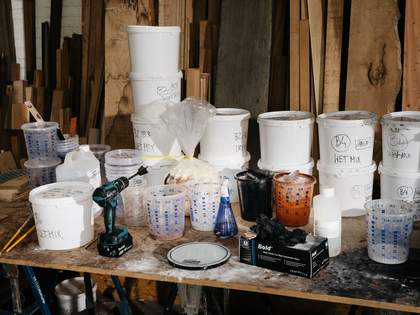
AL They might be something like the factory-line production, or the bootleg production, of your signature work.
ML Yeah! It has to be less meticulous, because the scale of the commission changes everything. If you’re going to look at something from five metres away, there’s no point in making elaborate details because they just won’t be visible. Also, mass production of sculptures has to be quick; everything has to be a bit sloppy, otherwise it immediately causes problems.
AL There’s always this kind of intentional sloppiness to your work, right? Other people might design something – especially a kinetic work or something containing mechanical parts – to make it work very well. But you specifically design things to convulse, shudder and leak – perhaps against the logic of the technologies that you utilise. What do you want to achieve through this messiness?
ML I think I’m drawn to it intuitively, because I want to be surprised and leave a lot of escapes. All the art that I admire is something that breaks out of form a little bit. The other reason is my nature. I am just messy! Over time, I’ve realised the best way is to make art that fits your personality. It takes a lot of effort to try to be something or someone else.
AL I’m stuck on that word ‘escape’, or the idea of creating something that you can also escape from. And also the idea of a sculpture that is a reflection of something that you are. I like how instability is built into a kind of resolve. Even though your sculptures can be quite abstract, they encourage people to project a lot of emotion into them. We feel there’s something pathetic or hurt about them, which is pretty weird, given that sometimes we’re just staring at a bunch of tubing connected to a motor. I also feel as if you’re an artist who has evolved with your sculptures. Could you share how you began to develop this kind of practice?
ML I think it’s to do with working with liquid a lot as a young artist, when I really didn’t know what I was doing technically. This led me to so many unpredicted failures. I was a lot less confident then, so I thought I couldn’t let accidents happen. If there was a leak in an exhibition hall, I would have to go there every morning before the show opened to try to scoop up all the liquid. I think I got weirdly attached to the excessive labour this demanded from me: to solve something so stupid, to mend this thing that was not mendable. My constant desire to create something that’s not containable or is a bit uncontrollable comes from this time, and at some point, I began to enjoy making more challenging works in terms of scale and materials.
AL It’s as if you developed an infrastructure for grappling with a set of materials that were all quite volatile, and in that volatility, you’re working through something quite psychological and philosophical. Do you use theory, philosophy and psychoanalytic theory in a way that also shapes this struggle with the materials you work with in your studio every day?
ML There are theoretical influences in my work, but I don’t think they relate to my process. It’s more where I get inspiration from. And there are many other things that are not necessarily related to theory or literature that are important to my work. If I give an artist talk, almost half of it is not directly about my work, but about things that really shook me.
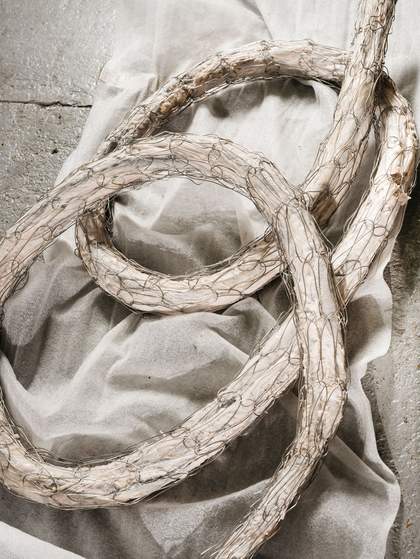
AL It sounds like you use cultural touchstones and other textual material as a kind of language scaffolding to support meaning around the work, but that these references aren’t the root. The work itself seems to come from the gut. I find it quite interesting for your work to be resistant to a direct verbalisation of meaning; to insist on that space of unformed-ness; and to invite a viewer to grapple with their own feelings that emerge in response, especially at the scale that your work is moving towards now. Somehow that’s very impressive to me – to be monumentally unarticulated.
I also have a feeling that your work’s insistence to stay in this liquid, murky zone speaks to a widespread melancholy of our times. Recently, I’ve been thinking about Lisa Baraitser and Judith Butler’s reflections on melancholia as a condition produced and reproduced from systematic cultural and social exclusions, resulting in incalculable and unnamable losses. What we have lost in this world, to colonial and imperial regimes, become absorbed into the structure of our egos, making us a leaking and dysfunctional social body.2
ML I really agree with the idea of melancholia not coming from inside but being a systematic result. I feel something as, for example, a Korean, or as a woman, or as a daughter. That’s when something really hits me hard. Actually, there is a Korean word for this: Han. It means sadness, but it’s a very specific type of deep sadness that somehow also includes a collective loss, like when your country is being destroyed.
AL Oh God, yes. And we see turbine power and cultural agendas working hand in hand as key engines of dispos- session. I’m often impressed by how your work enlists such simple materials to produce such gut-wrenching affects. I imagine that as you scale your work up to the level of the Turbine Hall, the task of transmitting a similar affective resonance also changes. Would you say this is one of the biggest challenges of working on this commission?
ML I think the biggest challenge is a lack of control. I’ve always considered myself as not that controlling as an artist, because I don’t care about perfection or slickness, and I work very flexibly with any conditions that are given to me. But in doing this project, I’ve real- ised that I normally work so flexibly because I am used to being free to change things on my own terms, even up to the minute before a show opens. Now, working with fabricators and the institutional apparatus, things are very strict and have to be decided far in advance.
Also, as you said before, the Turbine Hall is an in-between place. I cannot really control the space. It’s so different to a museum room or a gallery room, or even an outdoor commission. It’s out of my hands. Normally I feel like I’m very good at coming up with something that really works for a specific site. With this one, honestly, it’s a mystery.
Hyundai Commission: Mire Lee, Tate Modern, 9 October 2024 – 16 March 2025.
Mire Lee is an artist based in Amsterdam. Ami Lien is an artist, filmmaker and writer based in New York.
In partnership with Hyundai Motor. With support from The Mire Lee Supporters, The Mire Lee Supporters Circle and Tate Americas Foundation. Curated by Alvin Li, Curator, International Art, supported by Asymmetry Art Foundation, Tate Modern, and Bilal Akkouche, Assistant Curator, Tate Modern, and produced by Nancy Cooper, Production Manager, Tate Modern.

